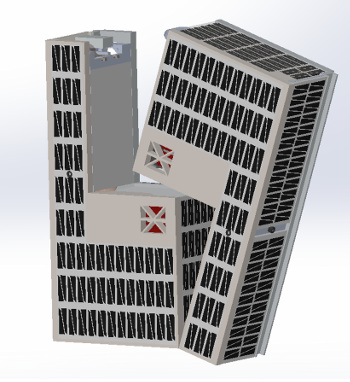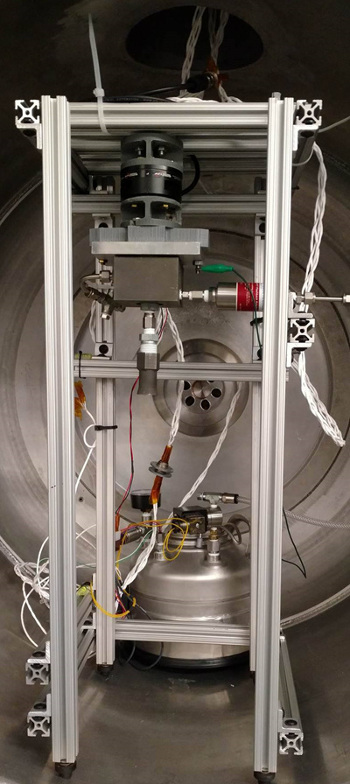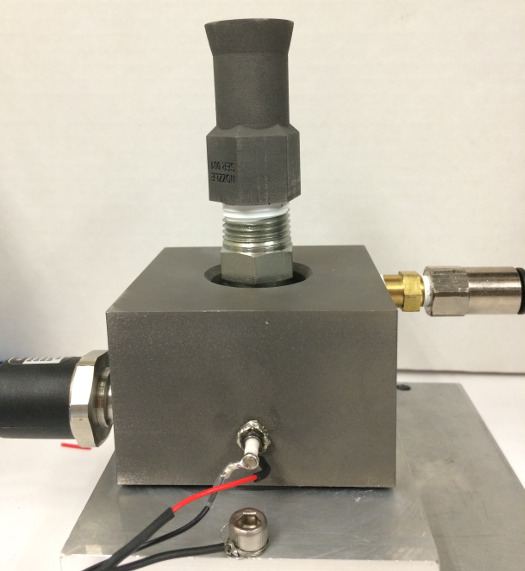 |
| September 27, 2016 | Volume 12 Issue 36 |
Designfax weekly eMagazine
Archives
Partners
Manufacturing Center
Product Spotlight
Modern Applications News
Metalworking Ideas For
Today's Job Shops
Tooling and Production
Strategies for large
metalworking plants
Water-propelled satellite shoots for the moon
A satellite propelled by the Earth's most abundant natural resource?
Yes, it's true.

In a novel design approach, the water-powered Cislunar Explorers cubesat spacecraft will separate into two pieces after deployment and try to move into lunar orbit. [Credit: Cornell University]
Cislunar Explorers, a team of Cornell University students guided by Mason Peck, a former senior official at NASA and associate professor of mechanical and aerospace engineering, is attempting to boldly go where no CubeSat team has gone before: around the moon.
Not only is Peck's group attempting to make a first-ever moon orbit with a satellite no bigger than a cereal box (and made entirely with off-the-shelf materials), it's doing so with propellant that you can obtain simply by turning on a faucet.
"This has a very important goal, and that is to demonstrate that you can use water as a propellant," said Peck, who served as NASA's chief technologist in 2012-13.
The Cislunar Explorers -- cislunar means "between the Earth and the moon" -- are in phase 3 of the four-phase Ground Tournament portion of the Cube Quest Challenge, sponsored by NASA's Space Technology Mission Directorate Centennial Challenge Program.
The challenge is offering a total of $5.5 million to teams that meet the challenge objectives: designing, building, and delivering flight-worthy, small satellites capable of advanced operations near and beyond the moon.
So far, Cornell's group has two top-three finishes, including a first-place finish in Ground Tournament 2 in the spring. The top three finishers will earn a ride on NASA's Space Launch System (SLS) rocket in early 2018 to compete in either the Deep Space Derby or the Lunar Derby. Cornell's team will compete in the latter, which focuses on propulsion for small spacecraft and near-Earth communications.
And while winning the competition is the team's main objective, it's not the only one, Peck said.
"Of course, we'd like to be the first CubeSat to orbit the moon," he said, "but even if we don't, if we can successfully demonstrate that water is all you need to travel in space, we've gone a long way toward achieving some important goals."

Cislunar Explorers thruster test stand: The thruster itself is in the top center foreground (hanging upside down), the propellant tank is behind the test scaffold, and the metal gray background is the vacuum chamber. [Credit: Cornell University]
Among them: Proving the ability to use resources available in space and ending our reliance on Earth-bound technologies to explore space further. "Massless" space exploration has been a goal of Peck's for years.
If all goes according to plan, the Cislunar Explorers' CubeSat will take off aboard the SLS rocket and, somewhere between the Earth and moon, be jettisoned from the payload bay.
The satellite is actually two "L"-shaped halves, and they will split apart and gradually separate miles from each other, both on a course for the moon's atmosphere. The twin satellites will spin as they go, their spin creating angular momentum -- think a spinning top -- that will help keep them from tumbling off course.
With energy captured from the sun, water stored in tanks at the bottom of the "L" is electrolyzed into hydrogen and oxygen gases, which will combust in short bursts, 30 minutes to an hour apart, to provide propulsion. The spinning will also separate the liquid water from the combustible gases.
As the craft enters the moon's gravitational pull, it will slow down and be swung into a distant Earth orbit, eventually reconnecting with the moon days later. It's during this second rendezvous that Peck and his team plan for the satellite to be traveling slowly enough to be sucked into lunar orbit, some 6,200 miles above the surface of the moon.
In addition to the water-based propulsion, the other core technology to be demonstrated by the team is optical navigation, said project manager Kyle Doyle, a doctoral student in aerospace engineering.

Cislunar Explorers electrolysis thruster, made from 3D-printed titanium. [Credit: Cornell University]
According to Doyle, cameras onboard the craft will constantly take pictures of the sun, Earth, and moon and compare their apparent sizes and separation with their ephemerides -- where these bodies should be at the time the pictures were taken.
"Using fairly simple geometry, the spacecraft can say, ‘OK, I must be here, because these bodies look like this,'" Doyle said. "It's very much like ancient explorers using the sun and moon to navigate. What's old is new again."
The competition is scheduled to end one year after the SLS launch.
Source: Cornell University
Published September 2016
Rate this article
View our terms of use and privacy policy
